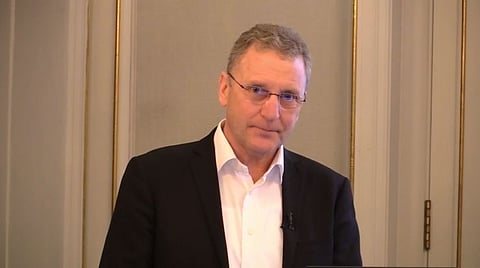

Grieg Seafood CEO Andreas Kvame, pictured during this morning's presentation of the Q4 results for 2023.
Photo: Grieg Seafood webcast.
Grieg Seafood ASA has today unveiled its financial results for the fourth quarter of 2023, looking back on a difficult quarter dominated by a series of biological problems, particularly at its Finnmark site in northern Norway.
"It has been a tough quarter, and my colleagues have worked hard in all regions to implement improvement measures and move forward. I want to thank them all for their efforts. I am confident that we are on the right path and that we will see results during 2024,” said CEO Andreas Kvame.
The company achieved a harvest volume of 21,767 tonnes, slightly up from the previous year's 21,186 tonnes. However, Grieg faced a downturn in its operational earnings before interest and taxes (EBIT), recording a loss of NOK -67 million (EUR -6.2 million; USD -6.43 million) compared to a profit of NOK 156 million (EUR 13.73 million; USD 14.98 million) in the same period of 2022.
The quarter's operational EBIT per kilogram plummeted to NOK -3.1 (EUR -0.27; USD -0.30) from NOK 7.4 (EUR 0.65; USD 0.71) year-on-year, influenced significantly by adverse biological events in Finnmark.
Despite these challenges, the company closed the year with a robust full-year operational EBIT of NOK 780 million (EUR 68.64 million; USD 74.88 million), equating to NOK 10.8 per kg (EUR 0.95; USD 1.04).
Region-wise within Norway, operational EBIT/kg in Grieg's Rogaland operations was affected by a slight decrease in the superior quality share and the timing of harvests, combined with higher farming costs due to previous ISA incidents.
However, Grieg's operations in Finnmark faced major setbacks due to a series of biological problems, leading to reduced harvest volumes and a weaker financial performance.
A damaging combination of spiro parasite, winter ulcers and jellyfish led to unsatisfactory results in Finnmark, says CEO.
Photo: Grieg Seafood webcast.
“Our results in the fourth quarter were impacted by continued weak biological performance in Finnmark. The Spiro parasite, winter ulcers and jellyfish have impacted survival rates and operational efficiency in Finnmark and led to reduced volumes, increased handling cost and lower price achievement."
"I am not satisfied with the results, and we have taken measures to address the challenges both in the short and medium term," Kvame said.
"The Spiro alone is estimated to cause a total loss of NOK 900 million since it was detected in 2022 at our freshwater facility in Finnmark, most of which has previously been realized. We have implemented measures to prevent Spiro from entering our facility again with good results. All fish that was transferred to the ocean farms in 2023 were Spiro free, and we expect impact from Spiro to cease after we have harvested out the last fish groups from the 2022 generation during Q2," Kvame continued.
A worker at a Grieg Seafood salmon farm in northern Norway.
Grieg had better news from Canada during the fourth quarter. Grieg's British Columbia operations showed improvement despite negative EBIT/kg, attributed to better seawater survival rates. Newfoundland also marked a significant achievement with a successful first harvest, albeit below the anticipated volume.
"In Newfoundland, we successfully conducted the first harvest with a volume of 3,184 tonnes, a superior share of 97% and favourable reception from the North American market. The seawater production in Newfoundland continues to be strong with a 12-month survival rate of 95%," Kvame said.
The company said it is still in the process of identifying long-term partners for the ongoing development of its operations in Canada.
Grieg Seafood is actively advancing its post-smolt strategy, constructing a new facility in Finnmark with a 3,000 tonnes capacity, with the aim of enhanced biological control and growth.
The company is also embarking on a cost reduction program to save NOK 150 million (EUR 13.2m / USD 14.4m) over two years, enhancing efficiency and profitability.
Looking ahead to 2024, the company anticipates a global increase in Atlantic salmon harvest by 2%, expecting sustained strong market prices due to limited supply growth and continued robust demand.
Grieg Seafood has set a global harvest target of 81,000 tonnes for the year, and 17,800 tonnes during the first quarter.
